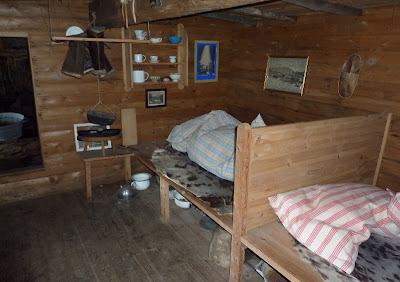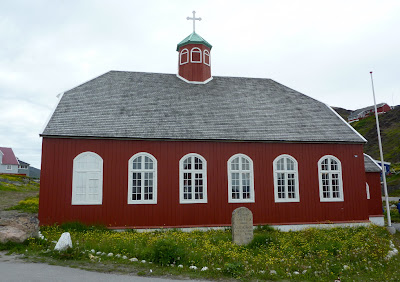Here in Greenland "taking your truck into town" has a whole new meaning.
In 1993-4 the artist Aka Hoegh presided over the Stone & Man project, aimed at transforming Qaqortoq into an open air art gallery. It attracted numerous artists and there are now 40 works in the town. Several of these were just opposite our dock.
There was also a stand of Greenland's national flower, the Niviarsiaq -- commonly known in North America as broad-leafed fireweed.
Joan and I joined one of the groups taking a guided tour. One early stop, after the Stone & Man works, was a museum. Here is a room showing typical early 20th Century living for the Greenlanders; the resident Danes usually lived more comfortably.
The top floor is dedicated to Charles Lindbergh, who stayed here during part of his 1933 visit to Greenland, scouting possible routes for transAtlantic flight on behalf of Pan Am. The plane he flew acquired its nickname of Tingmissartoq in Greenland.
Elsewhere there was this display of Inuit costume.
And a display of various styles of that Inuit invention, the kayak.
Then our group moved on to the town fountain, the oldest in Greenland, built in 1927. I apologize to our guide for taking this picture when she was busy answering a question; there will be a better one towards the end.
This is the sign at the nearby fish market.
A vendor is selling seal meat.
The next stop was the older of two Lutheran churches in Qaqortoq, established in 1832.
We were able to go inside.
Directly adjacent to the church is a small mortuary chapel. This stores coffins (occupied) which can't be buried in winter because of the frozen ground, but must wait until spring. The municipality digs spare graves each summer based on an actuarial estimate, but there are years with extra demand.
Here our group disbanded to allow individual exploration. Joan and I used the provided map to investigate two viewpoints. On the way, we saw this piece of yard art.
The first viewpoint was uninteresting, but the next one provided a great view down to the harbor. The lupine in the foreground is commonly planted here and in Iceland to combat erosion.
Along the way we passed apartment blocks with unusual porch/stairways, and children playing on or with whatever was handy.
Then Joan and I scrambled down the hill to the Hotel Qaqortoq, visible from our viewpoint. At 4:30 there was a Greenlandic Food Tasting, buffet style, at the hotel, and we didn't want to be late. The items on offer included dried cod, whale blubber, lumpfish roe, dried seal meat, smoked Arctic trout, reindeer paté, and more, all of which I failed to photograph. I skipped the blubber and roe, but tasted most of the rest.
After dinner aboard ship we were treated to a performance of traditional Inuit drum dancing, whose origins are at least 4500 years old. These dances can reflect personal expression, be a source of entertainment, and a method of dueling to settle serious disputes. Here our guide from the afternoon stands beside the performer.
I recorded this shorter, one-minute dance. Note that the drummer strikes the edge of the drum, not the stretched skin.
After our guests departed we set sail again, with another worthwhile sunset at hand.
Tomorrow we will visit Brattahlíð, or Brattahlid, Erik the Red's estate and probably the site of the first church in the New World.






















































